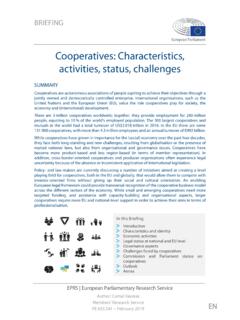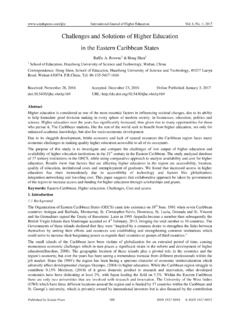Transcription of COLLABORATIVE LEADERSHIP
1 COLLABORATIVELEADERSHIPE ngaging collective intelligence to achieve results across organisational boundariesWHITE PAPER 2 CASE STUDY | Ignite The Spirit: AkzoNobel s Journey from multi -Local to GlobalCopyright 2016 Oxford LEADERSHIP 3 COLLABORATIVE LEADERSHIP is an increasingly vital source of competitive advantage in today s highly networked, team-based, and partnership-oriented business environments. Yet few leaders have been trained to lead collaboratively, especially those at more senior levels who climbed the organisational ladder in a different era. In this paper we describe key practices of COLLABORATIVE LEADERSHIP and identify critical LEADERSHIP competencies associated with it, highlight common barriers and suggest next steps for companies interested in developing leaders who can collaborate to transform business for COLLABORATIVE LEADERSHIP Leaders today need an expanded repertoire of skills and a new mindset to succeed in an ever-more fast-paced, chaotic, and highly competitive business environment.
2 They must be able to think strategically in a global context, articulate an inspiring vision across cultures, and make wise choices amid complexity and uncertainty. They must lead global teams, build dynamic networks, and grow the company s ability to compete around the world. Increasingly, this calls for COLLABORATIVE LEADERSHIP and the creation of COLLABORATIVE cultures that can harness the knowledge and expertise of all stakeholders to innovate, partner effectively, compete, and win. By COLLABORATIVE LEADERSHIP , we mean the process of engaging collective intelligence to deliver results across organisational boundaries when ordinary mechanisms of control are absent. It s grounded in a belief that all of us together can be smarter, more creative, and more competent than any of us alone, especially when it comes to addressing the kinds of novel, complex, and multi -faceted problems that organisations face today.
3 It calls on leaders to use the power of influence rather than positional authority to engage and align people, focus their teams, sustain momentum, and perform. Success depends on creating an environment of trust, mutual respect, and shared aspiration in which all can contribute fully and openly to achieving collective goals. Leaders must thus focus on relationships as well as results, and the medium through which they operate is high-quality WHITE PAPER | COLLABORATIVE LeadershipWorking in this way can be challenging for leaders who have established a track record of success by exerting unqualified command over the people and resources under their control. Few leaders have been trained to lead collaboratively, especially at the senior level, and in many cases the culture and reward systems in organi-sations discourage collaboration.
4 Developing leaders with the capacity to collaborate and creating aligned cultures thus go hand in hand. It s incredibly challeng-ing work, but increasingly vital for business focus in this paper is on COLLABORATIVE LEADERSHIP of teams, but the same principles and practices apply to creating more COLLABORATIVE CONTEXT FOR COLLABORATIVE LEADERSHIP A COLLABORATIVE approach won t wholly supplant command-and-control LEADERSHIP in most companies. Yet a multitude of forces are driving the growing need for COLLABORATIVE LEADERSHIP in today s organisations, most notably globalisation and the ICT revolution. Companies must align strategy, coordinate operations, manage teams, and leverage synergies across increasingly complex and distributed organisational structures. Flatter hierarchies, matrix structures, and cross-functional teams are increasingly common, meaning leaders must often work with people over whom they don t have formal authority.
5 Managers need to engage employees more fully at every level to improve efficiencies, increase agility, understand customer needs, and innovate. Teams need to draw on diverse perspectives from both within and outside the organisation to solve problems and identify opportu-nities, especially when familiar ways of working no longer apply. The success of business models based on partnerships, strategic alliances and complex supply webs depend on the ability to collaborate. Driving all this is the dizzying evolution of information and communication technologies, especially the instantaneous, always-on, hyper-connected business and social networks that now cut across all organi-sational boundaries. While many companies are still finding their way when it comes to using social media and other interactive technologies productively, they are transforming how people connect, how businesses operate, how companies compete, and how communi-ties organise and govern this context, competing successfully requires leading collaboratively.
6 In addition to the core capacities all leaders must have, they must now be able to build trust, align diverse interests, share power, and sustain high-quality lateral cooperation with their peers while facing intense pressure for performance. They must be powerful shapers of COLLABORATIVE cultures, able to harness the collective intelligence and leverage the distinctive competencies of employees throughout their organisations to adapt and innovate with agility and speed. In larger industry or social contexts, they must know how to forge generative alliances with business partners or community leaders who have their own strategic agendas, organisational cultures, decision-making processes and egos. Many companies are just recognising this need. In a 2007 survey of private and public sector leaders in the UK, almost nine out of ten senior executives said that COLLABORATIVE partnerships were key to their organisation s success, but fewer than one in ten said they had the capacity to partner company that has taken up the challenge to transform both LEADERSHIP and culture is AkzoNobel s Decorative Paints, under the LEADERSHIP of CEO Tex Gunning and his 2016 Oxford LEADERSHIP 5 TRANSFORMATION IN AKZONOBELTex Gunning faced several challenges when he was named CEO of Decorative Paints (commonly called Deco) in 2008.
7 Most importantly, he had to re-ignite growth and increase profitability in a declining economy. At the same time, he had to integrate a recent acquisition while re-structuring the company to leverage its global reach and compete more effectively in diverse local that time, Deco was characterised by a multi -local organisational structure that encompassed over 20,000 employees in dozens of independent business units around the world. It was ill-suited to operate as a single global entity and to leverage its people, competencies, and capabilities to execute on its strategy. Gunning realised that simply moving boxes around on the organisation chart would not produce the kind of fundamental transformation required in the business. As in other companies, more and more work and learning in Deco takes place not through the traditional hierarchy, but through matrix structures, cross-func-tional teams, functional councils, communities of practice, and other boundary-spanning networks a constantly changing organisational ecosystem that Deco s employees call the spider web.
8 Gunning also realised that strategy-driven structural change would require a change in Deco s culture, starting with a change in its LEADERSHIP culture. Leaders needed to see themselves, the company, their markets, and the communities in which they operated in much more interdependent ways. They needed to develop collaboration as a core competency. In an interview, Gunning described it this way:We have to get into collective LEADERSHIP and move from an independent achiever structure and culture .. to an interdependent COLLABORATIVE structure and culture, led by collective and COLLABORATIVE LEADERSHIP .. a culture where structures, processes and systems improve our ability to work across organisational and political boundaries and support and empower partnership with Oxford LEADERSHIP , Deco s global LEADERSHIP team designed and implemented a leader-ship program that was based on these principles, aligned with its business strategy, and scalable to all levels of the organisation.
9 Ignite the Spirit learning journeys brought leaders and their teams into frank and open conversation about their purpose, priorities, and action plans. Follow-up activities began to shift Deco s LEADERSHIP culture from a me -based orienta-tion to a we -centred approach and set the stage for a broader organisational restructuring based on a growing commitment to collaboration and collective WHITE PAPER | COLLABORATIVE LeadershipSince embarking on this transformational initiative, Deco s decline has been reversed. In 2010, the company generated a turnover of billion, a 9% increase from the year before. EBITDA increased by 13% and employee engagement scores increased significantly. Knowing the transformation process has just begun, Gunning keeps everyone focused on a new vision of how the company has to operate to succeed:In a truly complex organisational environment, a global company can no longer be dependent on a command-and-control logic.
10 Our new vision still has an element of command, but the mechanism for moving in the same direction has to be entirely different. The old structure is a role-defined organisation. The new structure is purely dependent on the relationships that people share and the quality of the conversations that takes place. We need to create new DIMENSIONS OF COLLABORATIVE LEADERSHIPO ther companies have taken different routes to transforming their LEADERSHIP cultures and fostering greater collaboration. Cisco created an extensive network of boards and councils dedicated to develop-ing new strategic initiatives (and is now streamlining that structure as it seeks the right balance between over- and under -collaboration). Sanofi drew on the World Caf - a large-scale dialogue process for evoking collective intelligence - to transform its internal strategy formation process and LEADERSHIP s relationship to external partners.









